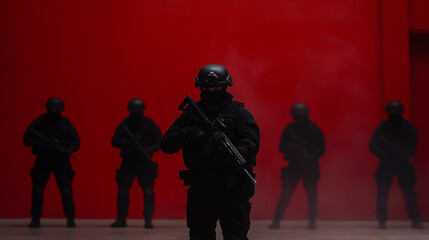This article has been contributed by The Survival Mom for your reading pleasure. Visit The Survival Mom Blog for more emergency preparedness information and resources.
“All for one and one for all!” makes a great family motto when it comes to an emergency evacuation. When everyone has designated jobs and knows exactly what to do, your family can be packed and out of town before most other families grab their toothbrushes. To make this happen and avoid hysteria, chaos, and needless tears, your family needs an evacuation plan.
When I first began thinking about the possibility of evacuating from our home, I visualized sheer panic. Immediately, I realized the need for a written list of procedures posted in two or three locations and a family meeting or two to insure that everyone was informed and on board. As I put our evacuation plan together, five basic steps became apparent.
1.    Make provisions for animals.
2.    Pack personal necessities, food, and water.
3.    Prepare the house.
4.    Pack important documents and a computer.
5.    Insure the vehicle is ready to go.
Follow these five simple steps to create your own evacuation plan.
1. Make provisions for animals
I put this at the top of my list because of the words in Proverbs 12:10a, “The godly care for their animals,†and because I’m crazy about our four dogs and our lone cat, Daisy. There were so many unnecessary tragedies that involved beloved pets in the aftermath of Hurricane Katrina, and after watching that unfold, I determined that I would never leave ours behind.
Once you’ve made the decision to evacuate, one of the first steps should be to determine how best to care for each animal. Certainly, most cats and dogs will need to be either evacuated with you or transferred to a safer location. Either way, you don’t need them underfoot as you rush around, so a first step will be to put them in crates or carriers.  Delegate this task to one or two family members.
Depending on the size of your dogs and cats, you may want to first load their crate in your vehicle and then the animal(s). So, first on my list is to load the dog crate in the Tahoe, and put each dog inside. We have four small dogs so they all fit, in a cozy sort of way!
Pre-position collars, leashes, and water and food bowls in the crate, along with some dog food, double-bagged in two large Zip-Locs. (Ants love dog food!) Add the dog, and you’re good to go.
If your cat isn’t used to being in a carrier, now is the time for Crate-the-Cat practice! Along with her crate, pack a small package of kitty litter and her food.
If you’re the proud owner of fish, reptiles, rodents and/or farm animals, consider whether or not you’ll take them along, leave them on their own with a plentiful supply of food and water, or transport them to another location. Have a Plan B for their care in case circumstances suddenly change. For more tips, read this.
2. Personal necessities, food and water
While the designated family member is rounding up the animals, delegate who will be responsible for the following.
- Load 72 Hour Kits, or Bug Out Bags, if you have them. Take some time now to put these kits together while you have time and are not under any duress. I carry a Vehicle 72 Hour Kit in my Tahoe at all times in case of emergencies while we’re on the road. If we only had time to grab our Kits, at least we’d have the most necessary items for survival to get us through the first three or four days.
- Load firearms and ammunition. Guns are one of the first things vandals look for, and I don’t want ours getting into the wrong hands. In a worst case scenario, we may need them for defense.

- Cash.  I usually keep this in twenty dollar bills or smaller. In case of a widespread electrical outage, ATMs and credit/debit card machines won’t be working. I want to be sure we can pay for hotels, gas and food. A roll of quarters is a good idea if you may be washing clothes at a laundromat or using pay phones, which, by the way, are often up and running before land lines and cell phone towers are operational.
- An emergency toilet: a handy-dandy five-gallon bucket with plastic liners. This bucket can also hold a couple of small blankets, toilet paper and a bottle of bleach/water mixture.  You can even buy a toilet seat designed to fit one of these buckets. I’ve read accounts of the Hurricane Ike evacuation in 2008, and I don’t want my family using the side of the road as a toilet. Enough said.
- Load additional food and water, as much as there is room for. Your 72 Hour Kits will contain emergency provisions, but extra food will always come in handy.  Collapsible water containers are a good option since they gradually take up less space as they’re emptied.
- Bedding items, such as sleeping bags, blankets, and pillows will add comfort and reassurance. How much you can take with you will depend on how much room you have left in your vehicle. I always keep a couple of lightweight blankets rolled up under the back seat, just in case.
- Pack tools we might need. A claw hammer or a Phillips screw driver might make all the difference in the world in a survival scenario.
- Family heirlooms and valuables, including photos. Now, before a crisis hits, would be a good time to transfer irreplaceable photos to CDs. It’s much easier to grab a few CDs than armfuls of photo albums, or, if you’re like me, boxes of loose photos.
3. Prepare the House
As you drive away from your home, no doubt you’ll have feelings of sadness and, perhaps, loss. A written plan to protect your home will increase the chances of having a home to come home to. Here is a checklist I’ve used.
- Turn off gas and water.
- Go out to your electrical panel and switch off everything except for the breakers marked for the kitchen.
- Unplug everything in the house except the refrigerator, freezer and a kitchen lamp. Even if our entire neighborhood is evacuated, I would just rather my home look occupied.
- Shut down and unplug the computers.
- Close and lock all windows. Close blinds and curtains.
- If your emergency requires it, board up the windows or put up your storm shutters.
- Depending on the current weather, turn off air conditioner and/or heat or set them at minimal levels. (Make sure to leave those breakers in the ‘on’ position on your electrical panel.)
4. Pack important documents and a computer
- Load our strong box. (This contains originals of things like Social Security cards and birth certificates.)
- Pack my Grab-and-Go Binder containing copies of vital financial and family documents and my Survival Mom Binder with printed information helpful in emergencies, such as maps and water purification instructions.
- Use a flash drive to save important business and financial information from our desktop computer. Pack flash drive with laptop.
- Pack our laptop computer. Be sure to include the charger!
5. Insure the vehicle is ready to go 
Hopefully, you’ve been keeping an eye on weather and news reports and have made sure your vehicle’s gas tank is full. In addition to that simple, obvious step, here are a few more.
- Load extra filled gas cans, if you have them.
- Check air pressure of tires.
- Be sure you have everything necessary for dealing with a flat tire, including a spare.
- If your vehicle is likely to need it, pack extra engine oil and other fluids.
Delegate, Post, and Rehearse
Now that your plan is finished, discuss each step with your family and delegate each task to family members. Even the youngest will want to be useful, and in a crisis situation, assigned tasks will help defuse feelings of panic and confusion. It’s more difficult to become hysterical when you have something to focus on. Not impossible, just more difficult!
There’s one final step. Will this really work? How much time will it take, and will there be any room for passengers in your vehicle once it’s loaded? It’s now time for an evacuation drill. This will help refine your plan and give everyone a real-life rehearsal. Post your final plan around the house, and then, when they least expect it, start the drill.
“Hey kids!  There’s a mountain of red hot lava rushing toward us, and we have to be out of the house in thirty minutes. Everybody know their jobs? Okay! Ready…..GO!!!”
Start the timer, and let the fun begin! Be sure to follow up with a family meeting to discuss what went well and what needs to be improved upon. When your plan is in place, a potential evacuation will be one crisis you won’t have to worry about.










0 Comments